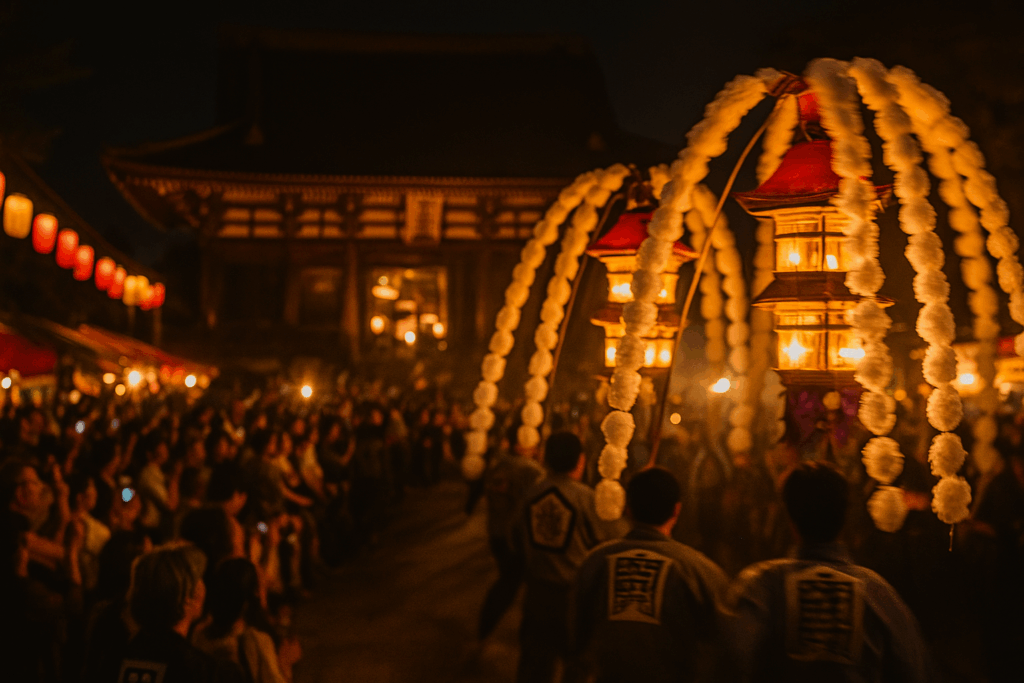
Japan’s love for light goes beyond decoration.
From the quiet glow of temple lanterns to the dazzling illuminations of today,
every sparkle tells a story of how the Japanese celebrate life, memory, and hope through light.
This is a journey through those lights — from my own childhood memories to the glowing cities of modern Japan.
The Origin of Light — Oeshiki at Ikegami Honmon-ji
My earliest memory of light begins at Ikegami Honmon-ji Temple,
in Tokyo’s quiet Ōta Ward.
I grew up in a family that moved often, never settling deeply into one region,
but the Oeshiki Festival, held every October, has never left me.
Hundreds of paper lanterns—mandō—swayed in the night breeze,
their lights carried by people walking in rhythm to the beat of drums.
It wasn’t just a festival.
It was a river of light, flowing with prayers.
Whenever I see illuminations in modern Japan,
my heart somehow returns to that calm, sacred night in Ikegami.
The Night When a Town Transforms
On festival nights in Japan, the familiar streets transform.
Lanterns flicker, laughter rises, and the air smells faintly of sweet syrup and incense.
Children tug at their parents’ hands; friends call out to each other across the crowd.
For me, those were the nights of yukata—the summer kimono.
Wearing one felt like stepping into another world.
You’d promise to meet friends at the shrine gate,
or unexpectedly run into a classmate whose yukata looked especially beautiful that night.
We’d blush, laugh, and pretend not to notice each other—
tiny, fleeting scenes that somehow stayed forever.
That is how Japan celebrates its hare no hi—days set apart from the ordinary.
A single evening of light and laughter becomes a quiet ceremony of joy.
Living with Light
For centuries, the Japanese have lived with light, not against the dark.
The fiery glow of the Nebuta floats in Aomori,
the gentle lanterns of the Tōrō-nagashi drift down rivers in summer,
and fireworks bloom only to vanish—beauty defined by impermanence.
These were never meant to conquer the night.
They were meant to illuminate the heart within it.
In time, the glow of lanterns gave way to the neon of Ginza
and the strings of lights adorning shopping arcades.
Japan learned to decorate light itself—
to find warmth and dreams in its shimmer.
When Western Light Found a Japanese Home
Then came Christmas.
A celebration born in Western faith,
it arrived in Japan as something different—
a night for couples, families, and friends to share warmth in winter’s chill.
The Japanese have a way of softening what comes from abroad,
wrapping it in tenderness until it belongs to them.
Illumination, too, found its place in this gentle transformation—
Western light meeting Japanese air,
becoming a new kind of festival of affection.
The Modern Festival of Light
Now, when winter descends, cities across Japan shimmer with light.
Millions of tiny bulbs glow like the breath of stars,
and people once again gather—
not for religion, but for wonder.
Perhaps that is the essence of Japan’s light:
a bridge between prayer and joy, between the sacred and the everyday.
When I stand before an illuminated street,
I still feel the echo of that temple night in Ikegami—
a quiet reminder that light, in any age,
is how the Japanese remember to hope.
Travel Note
If you visit Tokyo in autumn, walk up the long slope to Ikegami Honmon-ji Temple during the Oeshiki Festival.
Thousands of lanterns flicker in the night air—a scene as timeless as it is moving.
And when winter comes, seek out Japan’s illuminations:
from Kobe Luminarie to Sapporo White Illumination—
each a continuation of that same story of light.
This article may contain affiliate links. For details, please see our Affiliate Disclosure.
